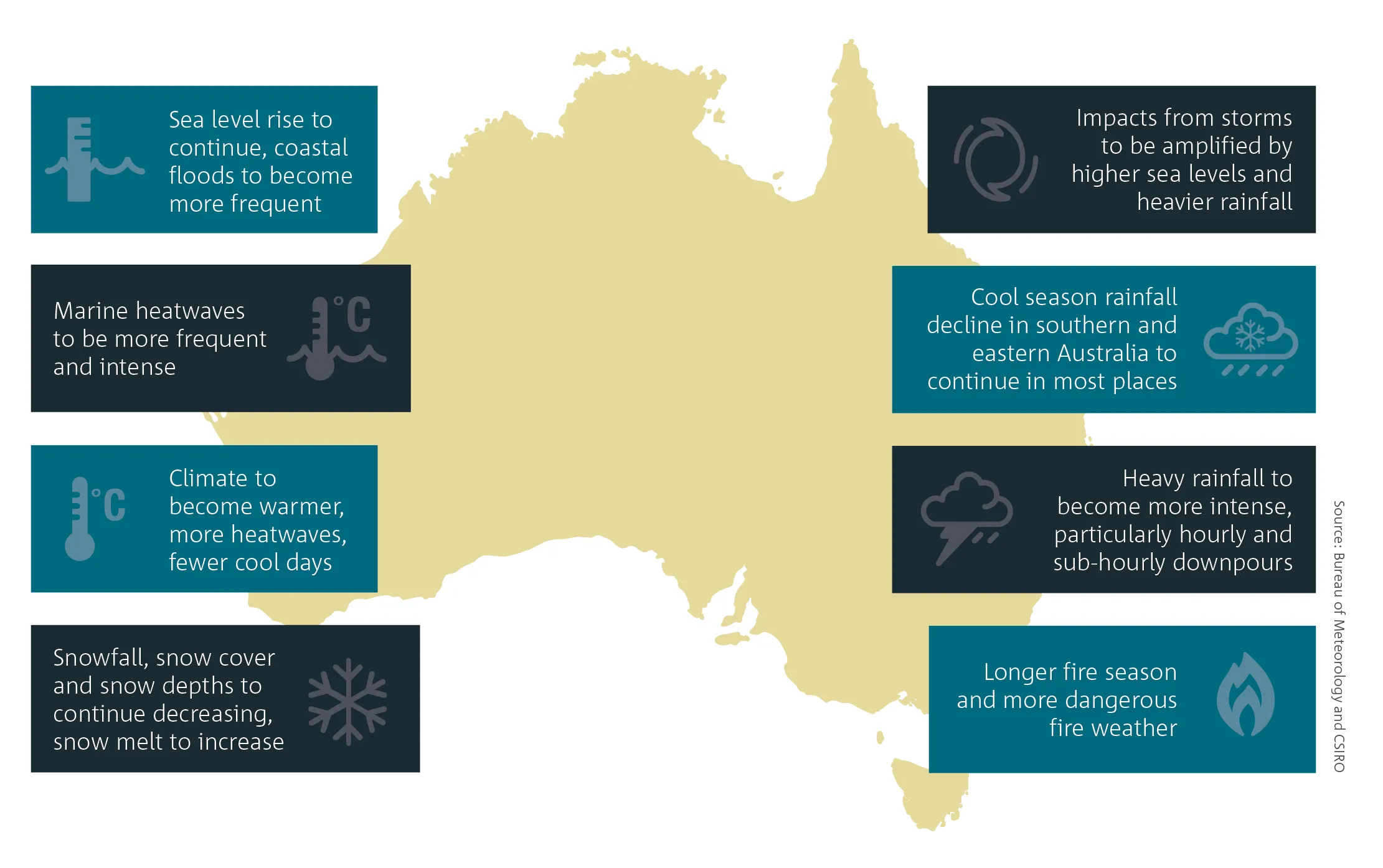Understanding climate change and its impact
Climate change is a long-term shift in Earth's average climate patterns. It can impact the health and wellbeing of our communities and ecosystems. This can affect Australians' lives and livelihoods.
The frequency and intensity of weather and climate extremes are linked with climate change. For example:
- more frequent and intense extreme heat events
- increased heavy rainfall and coastal inundation
- longer fire seasons and more severe fire weather
- more time spent in drought.
Such changes are happening faster than before. The past decade has seen record-breaking extremes, leading to natural disasters made worse by human-caused climate change.
The severity of impact on Australia depends on the speed at which global greenhouse gas emissions can be reduced.
Australia needs to plan for and adapt to the changing nature of climate risk now and in the decades ahead.
Global warming and the greenhouse effect
The greenhouse effect explains why Earth is warming. Along with this well-established theory, we have:
- observations of the air, water, land and ice
- paleoclimate records – data from natural sources such as tree rings, ice cores, corals, stalagmites, and ocean and lake sediments
- climate models.
This enables us to help prepare Australia for the impacts of climate change by:
- measuring and understanding the changes occurring in our climate system
- making projections of how the climate might change in the future.
How the greenhouse effect works
Energy comes to Earth from the Sun. To keep temperatures stable at Earth’s surface, an equal amount of heat must radiate back to space.
Greenhouse gases in the atmosphere, such as carbon dioxide (CO2), make it harder for heat to escape. This increases the temperature of the Earth’s surface, ocean and atmosphere. This is the greenhouse effect.
Without any greenhouse gases, the Earth’s surface would be much colder. The average temperature would be about -18 °C, due to the radiation balance alone.
For centuries before industrialisation, global average temperatures were relatively steady at just under 15 °C. This was due to nearly constant levels of greenhouse gases in the atmosphere.
Impact of greenhouse gases
Concentrations of greenhouse gases in the atmosphere are rising. This is mostly due to burning of fossil fuels and changes in land use. It's causing surface temperatures to increase.
Along with the increase in greenhouse gases there are more aerosol particles in the air. This has flow-on effects to clouds and further blocks heat escape.
The atmosphere and oceans will continue to warm until enough heat escapes to space. As carbon dioxide stays in the atmosphere for hundreds of years, further warming and sea level rise are locked in.
Impacts on Australia
Research by the Bureau, and internationally, has increased our understanding of the state of Australia's future climate. As greenhouse gas concentrations increase, the changes are projected to include:
- continued warming, with more extremely hot days and fewer extremely cool days
- a longer fire season for much of the south and east, and more dangerous fire weather days
- a further decrease in cool season (April to October) rainfall across many regions of the southern half of Australia, with likely longer droughts on average
- more intense short-term heavy rainfall events, even in regions where the average rainfall decreases or stays the same
- fewer tropical cyclones, but more likely to be high intensity, with ongoing large variations from year to year
- more frequent extreme sea levels and coastal flooding linked to coastal inundation and erosion
- continued warming and acidification of oceans surrounding Australia, with more and longer-lasting marine heatwaves
- an increased risk of natural disasters from extreme weather. This includes ‘compound events’, when multiple extreme events occur together.
Tracking Australia's climate
In Australia
At the Bureau, we've been observing Australia's climate for over 100 years.
We manage and maintain the equipment that collects the data that makes up Australia's climate record – see our Radar and equipment knowledge centre.
Using our scientific expertise, we curate and analyse the data, which includes Australia's long-term temperature record.
We work closely with other institutions in Australia such as CSIRO and the Australian Research Council Centres of Excellence.
In partnership with CSIRO, we operate the Australian Climate Service. It gives Australians access to information to better understand the risks posed by a changing climate, and the impacts. Climate projection tools are also available on the My Climate View website.
International collaboration
We take part in World Meteorological Organization initiatives for developing standards for climate monitoring practices. Our processes are reviewed by independent peers.
Various international groups independently produce temperature estimates for Australia as part of their own global and regional analyses. For example, the:
- National Aeronautics and Space Administration (NASA)
- National Oceanic and Atmospheric Administration (NOAA)
- Berkeley Earth
- UK Hadley Centre/Climate Research Centre.
These analyses produce similar results to our work.

